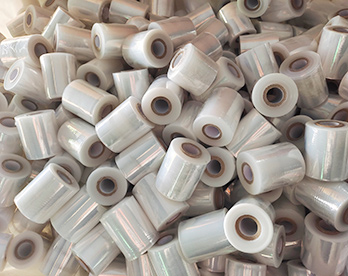

Craftsmen often struggle to distinguish between similar materials, especially stretch film and protective film, often confusing them. Let's explore the differences between stretch film and protective film.
Stretch film is typically made by adding an adhesive enhancer, such as PIB masterbatch, to PE film. It's used for cast film production. Its surface has a slight stickiness, allowing it to adhere to itself. It's primarily used to wrap and secure objects. There are several types of protective film. The most common is a blown PE film coated with an adhesive, much like the transparent tape we use in everyday life. It's primarily used to protect solid surfaces and can be removed when not in use. In short, stretch film is self-adhesive, while protective film is coated with an adhesive. Stretch film is very similar to the cling film we use daily, with the difference being that one is for industrial use, while the other is for food use.

Protective film is what we use on our phone screens.
It's a transparent, flexible, strong, non-toxic, and soft polyethylene plastic film that meets international environmental and hygiene standards. Stretch wrap can be cold-stretched in both the longitudinal and transverse directions without heating, allowing it to self-adhere to various products, maintaining tension for a long time without loosening. Its high strength and high elasticity allow it to be tightly wrapped around any shape, creating a single, integrated structure.
Stretch wrap uses less material than shrink wrap, does not require a shrink wrap machine, and conserves energy. It also offers advantages such as preventing loosening, rain, dust, and theft. Single-sided adhesive products reduce dust and sand during transportation and storage, minimizing surface contamination. Suitable for pallet transport and cargo pallet packaging, it offers moisture-proofing, dust-proofing, and labor-intensive processes, improving efficiency, protecting products, and reducing costs. It is particularly well-suited for pallet packaging and transportation, leveraging the film's toughness and self-adhesive properties, combined with the clamping effect of the wrapping layer during wrapping, to achieve the desired pallet packaging effect. It also supports the turnover of exhibited products (items, machinery), and is suitable for various applications, such as the transit of semi-finished products.
Features of Standard Protective Film
1. It effectively protects products from damage during processing, transportation, storage, and sales, preserving their integrity and gloss. Improve your product's market competitiveness!
2. Protective film can be used to protect the surface of products in industries requiring high-temperature resistance and high-temperature processing, preventing damage during high-temperature processing.
3. Waterproof and moisture-proof. Many industrial products require a cool, dry storage environment. These environments often remain humid over time, so using protective film to protect the surface can prevent moisture and mold.
4. Good adsorption properties. Currently, most protective films on the market are produced using co-extrusion technology. This type of protective film is characterized by its ease of use and inherent adhesiveness, making it easy to tear and apply. Characteristics of Stretch Protective Film
Since stretch film is a type of protective film, the common protective films mentioned above offer advantages such as excellent protection, waterproofness, moisture resistance, and temperature resistance. However, the difference lies in its emphasis on stretchability. Therefore, stretch film is commonly used for packaging and transportation. Using stretch film for packaging can reduce packaging costs by one-third compared to conventional protective film. Stretch film has a slightly lower viscosity than conventional protective film, primarily due to its emphasized stretchability. These are the differences between stretch film and ordinary protective film. Depending on the intended use, each has distinct characteristics, making it a specialized protective film.
What are the differences between stretch film and protective film?
1. Same material, different processes:
Stretch film uses polyethylene (PE), a tough material that cannot be crushed by ordinary plastic crushers. Protective film, on the other hand, is primarily made from ethylene through a polymerization reaction. Depending on the materials used and the addition of plasticizers, plastic wrap comes in various types, suitable for various situations.
2. Different uses:
Stretch film is primarily used for the sale and transportation of various products, including alcohol, cans, mineral water, various beverages, cloth, non-food products, and pharmaceutical packaging. Protective film is primarily used for microwave heating, refrigerator food storage, and packaging fresh produce and home-cooked meals. It is also used in household applications, supermarkets, and other applications.
3. Different environmental protection considerations:
Stretch film material (PE) offers advantages such as reduced atmospheric pollution, reduced waste disposal, recyclability, and lower overall packaging costs. However, some protective film manufacturers use PVC, a plasticizer that can penetrate the plastic wrap packaging at room temperature.